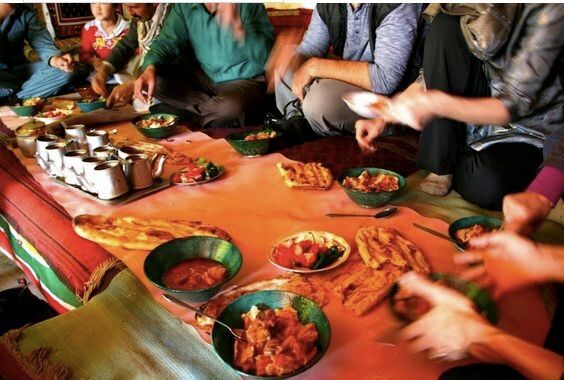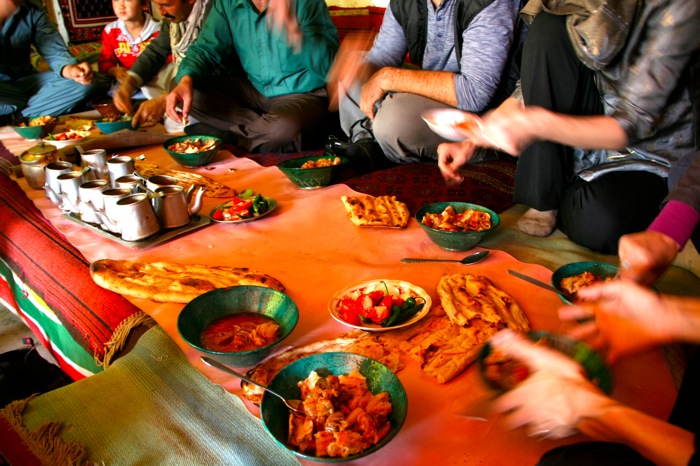

It should have come as no surprise that my favorite Dari word from nine intro language lessons would have been "lunch."
The first step to traveling respectfully is to learn how to say "hello" "thank you" and "goodbye" in the local language. The second step is to learn a few things food related, because no matter where you are in the world, you are going to need to eat.
Thanks to volunteer work and media support of the humanitarian organization Mountain2Mountain, my good friend and founder Shannon asked me to come along on a trip to Afghanistan to help produce the organization's latest endeavor, several full-scale public photo exhibits in and around Kabul. The first line in her email went something like, "I know going to Afghanistan is a big decision, so I will give you time to think about it." The second line went something like "but I hope you say yes because there's so much good food there. Can't wait to get you fresh squeezed pomegranate juice!"
Sold. She knows me all too well.
Not that the decision to travel to Afghanistan was based upon the prospect of eating new food, but tempting me with lamb kebab and pomegranates was certainly a smart choice on Shannon's part.
And that was how I found myself sitting on my couch in Portland repeating Dari phrases aloud to myself, overjoyed when I finally learned my first food related word: lunch. Naane chaasht directly translates to "bread noon," just as ingenious as our own "break fast" if not more so. Bread at noon? Makes complete culinary and linguistic sense.
I wasn't entirely sure what constituted Afghan cuisine, but based upon previous successful travel-food related adventures I planned ahead and mastered "Afghan food is very delicious" in Dari.
Food and travel go hand in hand, not just because it allows a view into a culture, but also because it provides a thread for connecting two people from two very different places. Put a pot of tea in the center of table and language barriers immediately begin to wash away.
Individual meals, much like people, are memorable. They can reshape your views of a culture. A country can be looked up in an encyclopedia, a Google alert set up online, but an insight into the everyday only comes from a one-to-one personal connection. In the same vein, it's easy to find a bulleted list of the top foods of a country, but a shared meal is more than individual ingredients and tastes, it's an all senses experience, tying together culture and friendship, breaking down barriers; a catalyst for connection.
"Chaaynaki," says Mohammed, the policeman next to me, the base of his rifle grounded on the floor and the barrel leaning against the side of the toshak that we are sitting on. He is pointing to the tray of silver teapots that the restaurant owner has brought to the table.
"Ah, chaay!" I respond. Chaay means tea, an important word to master in this culture, and I am convinced that teapots must equal tea.
"Nay, chaaynaki" he says with emphasis. Language nuances are always difficult.
I am of course lost, but our local fixer and translator is amused by my attempt to take on Afghan cuisine and frantically write every Dari reference to food in my notebook. He explains that "chaaynaki" refers to what we are about to eat, a lamb stew, served in teapots. We have prepped for this meal by ripping pieces of naan and filling the locally produced turquoise bowls we each have placed in front of us; the stew goes on top.
The restaurant is small, one toshak covering almost the entire space. At the front is the kitchen, a large copper stove and a wall full of ceramic teapots. Dressed in a long brown tunic and a traditional pakol hat, the restaurant owner maneuvers back and forth in the tight area, prepping our meal.
We have been invited in as guests of the rural village, Istalif, just north of Kabul, where we are presenting our first exhibition. In the Shomali plain, Istalif is tucked into the hills, free of international forces, and this time of year surrounded by yellow autumnal leaves. Three policemen accompany us to lunch, and because of their hospitality, it feels more like a celebration of community than security protection.
A teapot of stew is poured over the naan in each of our bowls, the spongy bread immediately soaking up the broth. Although there are spoons for emergency purposes, this is a hands-only meal, attention paid to using your right hand. The left hand is of course reserved for otherwise unmentionable activities.
As we have been working all morning to set up the exhibition, in the heat of the sun, amplified by the headscarf that I am still not used to, hunger set in long before we sat down on the toshak. The meal is therefore heightened; all senses open to what is happening in front and around us. Oily lamb stew covering my fingers, the guttural sound of Dari spoken between the policeman and their occasional laugh when I throw in a mazadaras here and there -- "this is delicious."
It is in fact delicious; warm and hearty, the intense taste of lamb that was most likely killed just down the street. In fact, only one hour earlier I had walked past a doorway with meat hanging in the air and the carcass and head on the ground; no factory farms anywhere in sight.
Food in Afghanistan has been explained to me as bread, oil and meat, a statement that is more or less spot on. In a state of hunger, our bowls are quickly cleaned, a few oily bread remnants at the bottom. A box of tissue sits in the middle, each of us taking a few to wipe off our hands, lips and chins. Eating a bowl of meat stew daintly with your hands simply can't be done.
Naane chaasht is of course followed by a round of tea, chaay. Through pointing and facial expressions Mohammed manages to teach me the word for both "hot" and "cold" in Dari. A plate of wrapped candies is served with tea, which he refers to as "chocolate." A slight error in translation, but because it gets the point across it's worth me letting it slide.
We wrap up lunch, and I profusely thank the restaurant owner, repeating several times mazadaras; always better to over express pleasure derived from food than not, even if all you have is one word. As I have my camera out, he motions for me to take a picture, pouring another cup of tea so that I can snap a photo of him in action. He clearly wants to assure that the memory of his restaurant and this meal doesn't disappear.
Little does he know, that won't require a photograph.
Originally published here.